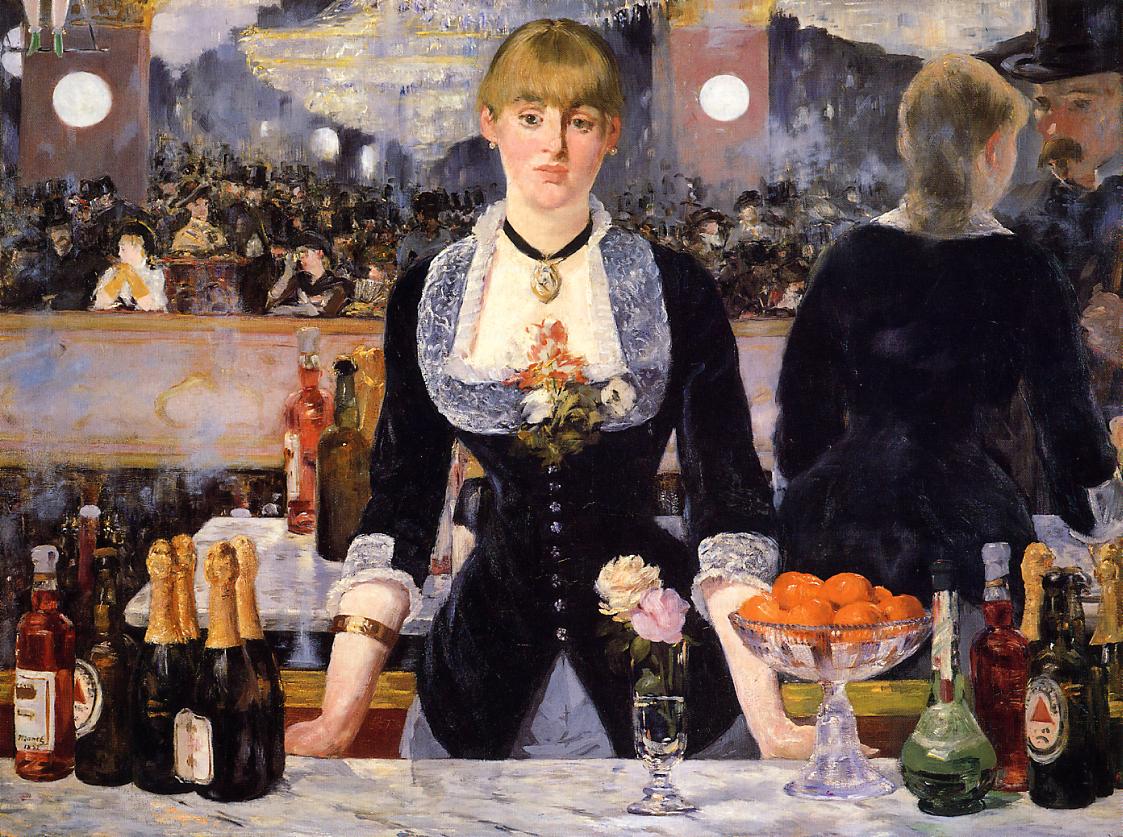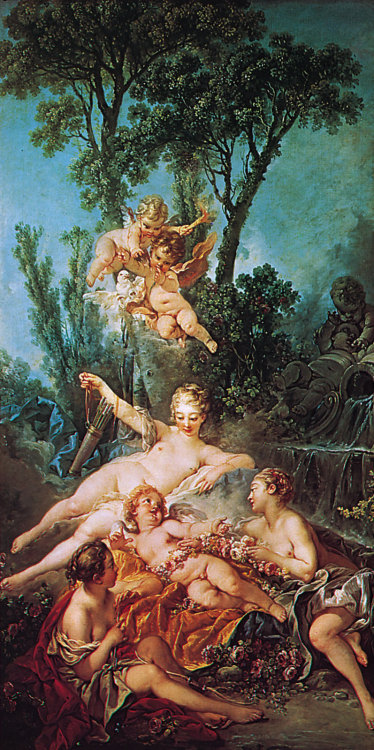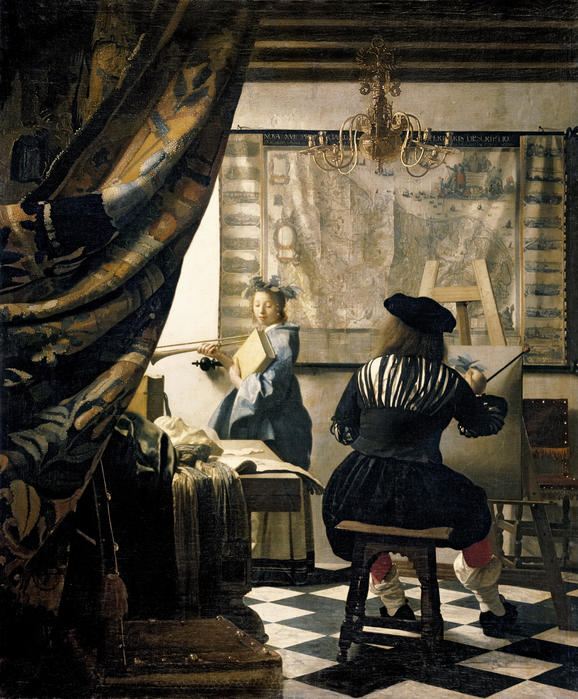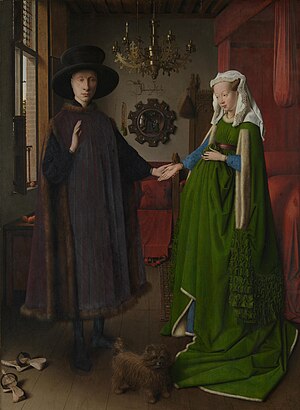Monday, December 3, 2012
Edouard Monet's A Bar at the Folies-Bergere.
This painting was painted by Edouard Monet called A Bar at the Folies-Bergere. It was painted in 1882 and it was oil on canvas. It is about 3 X 4 feet and found in Courtauld Institute of Art Gallery, London. The setting of the painting is in a Parisian Cafe. This painting reminds of some of the painting that were analyzed in previous chapter. The artist is shown in the canvas through a use of a mirror. It is a debate whether the guy shown in the mirror, at the upper right corner, is artist himself or a customer. The facial expressions of the barmaid seems disinterested and lost in her own world. She is quite detached from the world surrounding her. The background is blurred and just like Impressionism style the strokes are not refined and the painting does not show any enhancement. This style in the painting brings focus on the barmaid due to the unclear background.
Claude Monet's Impression: Sunrise.
This is a painting by Claude Monet called the Impression: Sunrise. It was painted in 1872 and it was oil on canvas. It is approximately 2 X 2 feet. This painting was called Impressionism because of the brushstrokes and quality of the sketch. It was a different style compare to the Renaissance, Baroque and other. The style was named Impressionism which incorporates "the quality of sketches--abbreviation, speed, and spontaneity" (Kleiner 801). The strokes in this painting are not attempted to blend so create a smooth look. The subjects in the painting are blurry and does not provide an accurate illustration of the view. In this style of painting, the canvas portrays the mixture of what artist saw and what he/she felt. Neither is it completely objective descriptions nor exclusively subjective perspective. It was a combination of objective and subjective. Impressionism was also different from other styles because it was one of the first style that was painted in the outside world and not in a studio.
Friday, November 30, 2012
Fuseli's The Nightmare
This portrait was painted by Henry Fuseli and it is called The
Nightmare. It is oil on canvas, painted in 1781, and it is 4 X 4 feet. Fuseli
is self-taught and expresses the fantasies of his innovative imagination in a
distinct manner. The themes of Fuseli’s painting are dark fantasies and
atmosphere of horror. In this portrait, a young woman is asleep across a bed
while her limp arm is dangling outside the bed. On her body, an incubus is
settled threateningly. During Medieval times, it was believed that a demon
called incubus preyed sexually on sleeping women. The ghostly horse in the
background bursts into the scene from behind the curtain. The title of the
painting nightmare urges the viewer
to imply it is due to the presence of the horse. However, the title is derived
from “night” and “Mara”. Mara was a spirit, which tortured and suffocated
sleepers. The illustration of the dark side of the human sub consciousness was first
attempted by Henry Fuseli.
Wednesday, November 28, 2012
Antonio Canova's Pauline Borghese as Venus
Antonio Canova painted Pauline Borghese as Venus in 1808. It was made out of marble and it is six and half feet long. It is in Galleria Borghese, Rome. It is a marble statue inspired by classical models. Canova is renowned artist for his classical gods and heros sculptures. In this portrait, Canova has depicted Napoleon's sister. Although Canova wanted to depict Pauline Borghese as the goddess of the Hunt, Diana, Borghese desired to be portrayed as Venus, goddess of love. Borghese is seen holding golden apple which is symbol of the goddess's victory in the judgement of Paris. She is shown as lying on a divan and gracefully holding her posture. This portrait was never got to be admired by Canova's fans due to the gossips of Pauline Borghese's affairs. Due to the gossips, Prince Camillo Borghese kept the sculpture isolated in his Villa. However, the existence of the sculpture was widespread and the artist and subject are disgraced.
Monday, November 12, 2012
Francois Boucher's Cupid a Captive.
This portrait called Cupid a Captive was painted by
Francois Boucher. It was painted in 1754 and it is oil on canvas. Due to being
favorite artist of Madame de Pompadour, Francois Boucher became famous in
French painting. He achieved success due to his graceful painting of spiritual
symbols and figures in narrow valley covered in pink and sky-blue light. The
infant, cupid, and the females create a pyramid on cool, leafy background
covered with draperies. The draperies covers and reveals the nudity of the cupid
and the female figures. This mastery piece was created by a mixture of Italian
and French Baroque devices such as crisscrossing diagonals, curvilinear lines,
and recessions. Boucher portrays sensuality and playfulness at the same time. It
is a vibrant and jovial Rococo painting style, which uses pastel colors.
Fragonard's The Swing.
This painting is by Jean- Honore Fragonard, greatest student of Boucher, called The Swing. It was painted in 1766 and it is oil on canvas. It shows an old bishop, convinced by a young man, swinging a young lady higher and higher. The young woman's lover is admiring her earnestly while sitting in the left hand corner of the painting. The woman is flirtatiously swinging her shoe toward the statue of cupid. The young lady is the focal point as the old bishop and the young man are both looking towards her. It shifts viewer attention toward the young lady. Because her shoe in the air is pointing toward the cupid, it makes the cupid part of the focal point along with the young lady. The finger on his lips of cupid statue can be interpreted as gesturing to be quiet and keep the peaceful environment. The soft light and glowing colors portrays sensuality in the theme. This portrait is an example of Fragonard’s work and late Rococo painting style.
Friday, November 9, 2012
Jan Vermeer's Allegory of Art of the Painting
This portrait is painted by Jan Vermeer called Allegory of Art of the Painting. It was painted in 1670-1675 and it is oil on canvas. Vermeer appears in the painting. His back is toward the viewer and dressed in historical clothes. The artist is deeply engrossed in his work at painting a model that is standing in front of him wearing laurel wreath and holding a book in one hand and trumpet in another. They are traditional features of Clio, the muse of history. Another history reference in the painting is the map on the back wall. Similar to other Vermeer’s painting, in Allegory of Art of the Painting the viewer is outside the space of action. Viewer is looking from the drawn curtains, which separates the artist’s studio and the house. Also the hidden window is radiating light on the painting and the model and illuminates that area. This painting was construed as an allegory by scholars and confirmed by Vermeer’s mother-in-law.
Rembrandt van Rijn's Anatomy Lesson of Dr. Tulp
This portrait was called Anatomy Lesson of Dr. Tulp by Rembrandt van Rijn. It was painted in 1632 and it was oil on canvas technique. In Rembrandt’s portrait, more movements are visible and his subjects are not evenly spread across the portrait while in Hals's painting subjects are fixed and spread across the canvas. In this portrait, a group of observers or students are gathered on side of the painting. It is very different from Hals' painting style. In the center, Dr. Tulp, physician, is dissecting a human corpse and teaching the students. Instead of typical traditional portraiture of horizontal, planar orientation, Rembrandt foreshortened the corpse and placed it diagonally. Although every observer is dressed correspondingly, they could be distinguished based on their facial expressions and body language. Observer’s attributes implies the varying degree of concentration paid on the lesson. One of the observers is paying attention to the anatomy manual near the corpse’s feet while another observer behind Dr. Tulp is gazing toward the viewer instead of the operating table. This painting was painted by Rembrandt at a very young age and it was the innovative approach of group portraiture was remarkable and well appreciated.
Sunday, October 28, 2012
Artemisia Gentileschi's Judith Slaying Holofernes
Artemisia Gentileschi painted Judith Slaying Holofernes during 1614-1620. It is oil on canvas and found in Galleria degli Uffizi, Florence. The painting could be considered as "dark" subject matter which Caravaggio favored. The significance of this portrait is the narration involving a heroic woman. It was favorite theme of Artemisia Gentileschi. The story depicted in the painting is from the book of Judith which relates to the delivery of Israel from the Assyrians. The Assyrian general Holofernes was capitulated by Judith's charm and invited her inside his tent for the night. Along with the help of her maidservant, Judith beheaded Holofernes when he was sleeping. The sword was substantial because it required entire strength of two women to wield. Blood streams are running from the bed sheet and to the floor while the women are cutting off Holofernes' head and the struggle through the slaying is perceivable in the hand movement of Holofermes. The contradiction between red bed cover and pure white bed sheet shows the cruelty of the scene. Tension is tangible within the atmosphere and through the expression of Judith and maidservant. Also the drama is heighten through the highlighting on the major action. The immediate contrasts of light and dark exhibits the effect of dramatization. The artist's unique portrayal of Judith is inconsistent to portraits of other artists, but the incorporation of drama, lighting, and coloring is typical of the Italian Baroque period.
David was Renaissance statue of biblical hero which was sculpted by re-owned artist such as Donatello, Verrocchio, and Michelangelo. Bernini also painted the biblical hero, David, in 1623. Although all of this artist have sculpted David, they all show different aspect of the battle between Goliath and David. While Donatello and Verrocchio show the victory of David, Michelangelo portrays David before the starting of the battle. Contrasting with the other artist, Bernini's David represents the combat itself. The element of time play a critical role in Bernini's expansive and theatrical sculptures. It is observed in David through the split second of maximum action. David is shown launching the stone while his muscular legs wide apart and firmly planted providing him the required balance for the pivoting motion. Also there is a bag full of stone around his hip which suggests he thought the fight would be lingering and grueling. The dramatic pose of David intrudes the viewer to think critically. The action showed in this painting requires space around it and different from the Renaissance style. David's pose and attitude direct attention toward the unseen Goliath. The visible tension on David's face escalates dramatic impact of Bernini's sculpture.
Albrecht Durer's Fall of Man
Albrecht Durer painted Fall of Man (Adam and Eve) in 1504. It is engraving and kept in Museum of Fine Arts, Boston. The training as a goldsmith from Durer's Father was developed in handling the burin, the engraving tool with an extraordinary proficiency. This portrait was first distillation of Durer's studies of the Vitruvian theory of human proportions. It was a theory which was based on arithmetic ratios. The figure of Adam and Eve are clearly outlined against a northern European Forest as a dark background. Durer's concept of "perfect" male and female figures, systematize sets of ideal human proportions in balanced contrapposto poses, were represented in the final print. However, he modulated his concept with naturalism by exhibiting his observational skill with the background animals and greenery. The animals, cat, elk,rabbit, and ox, represent humanity's temperaments based on the "four humors" developed by the ancient Greek physician Hippocrates. The animals populating the portrait are symbolic. For instance, the tension existing between cat and mouse symbolizes the relation of Adam and Eve at the crucial moment, intending to bite the apple, in Fall of Man.
Wednesday, October 24, 2012
Money-Changer and His Wife by Quinten Massys
The portrait was painted by Quinten Massys called Money-Changer and His Wife in 1514. It is an oil on wood technique.The details of figures and objects are presented by the artist suggest authenticity and observable facts. This painting shows the shift of Christians from religious duties to pursuit of wealth, which was becoming a prominent part of 16th-century secular life in the Netherlands. It shows the man scaling and weighing the coins on the table. The shift is observed in the actions of the wife who is more interested in the observing her husband weigh the money instead of reading her prayer book. The various religious symbols present in the picture are neglected by the couple and solely focus on money. Not only the couple, the reflected image of an old man in the convex mirror converse with another man, which could be referred to gossip or foolish chatter. Inscription in the church steeple behind the old man reads, "Let the balance be just and the weights equal" had tipped towards the pursuit of wealth for the couple in the portrait.
Sunday, October 14, 2012
Michelangelo Buonarroti's Creation of Adam
This portrait called Creation of Adam was created by Michelangelo Buonarroti in 1511-1512 in Rome, Italy. It shows the confrontation of God and Adam in primordial unformed landscape of which Adam was a material part. Lord wrapped in cloud of drapery and borne up by his powers, overshadowing the earth. The mighty hand of Lord sparks life into Adam through his extended hand. Classical myth, communication between god and heroes, is noticeable. The Olympian sense of God as a ruler of Heaven indicates High Renaissance thoughts combined with classical and christian traditions. There are two beliefs about the woman beneath the Lord's left arm. It was initially thought to be Eve, but now it is thought to be Virgin Mary with Christ child at her knee. If it is believed to be Virgin Mary, it suggests Michelangelo incorporated one of the essential tenets of Christian faith. The belief of Adam's original sin eventually led to sacrifice of Christ, which in turn made possible the redemption of all humankind. The focal point of the painting is where the fingertips of Adam and God is located. Everyone is looking toward the fingertips of Adam and God which makes the audience concentrate on the focal point. Also Adam's left hand's fingertip is horizontal to the Christ child.
Leonardo da Vinci's Mona Lisa
Mona Lisa by Leonardo da Vinci is considered the most famous painting in the world. It is a convincing portrait of an individual. Unlike most painting of secular painting, this portrait does not symbolize the social status of the individual. Mona Lisa does not wear any jewelry or hold any hallmark that represent wealth. It is persuading presentation of an individual. She sat quietly with her hands folded and a gentle smile on her face. Her gaze is directly at the viewer, while it was considered, during renaissance, that a woman should not look directly into a man's eyes. This portrait engages its audience due to this self-assured woman without any trap of power. Mona Lisa is an enduring appeal because of the background of a mysterious uninhabited landscape. This painting was painted in 1503-1505, oil on wood, and appears darker than the original painting. The atmosphere creates a distinctive mood and shows different perspective of Leonardo da Vinci. Also Mona Lisa reveals Leonardo da Vinci's fascination and skill with charcoal. This portait is prime example of Leonardo da Vince's famous smoky misty haziness through his subtle adjustment of light and blurring of specific planes.
Saturday, September 29, 2012
This portrait was called Holy Trinity which was painted by Masaccio between 1424-1427. It is a Fresco in Santa Maria Novella, Florence, which is a masterwork of Masaccio. It is great example of applying mathematics to the depiction of space by painting the composition on two levels of unequal height. The crucified christ is in the middle and Mary and Saint John appear on either side. God emerges from the back and is supporting the arms of the cross. It appears God is presenting his son to the worshipper. Also there is dove of the Holy spirit between god's head and christ's head. In the portrait, there is a tomb containing a skeleton above which it is inscribed in italian, "I was once what you are, and what I am you will become." The inscription above the skeleton is so true, and it reminds the spectator the reality of life. The vanishing point of the painting is at the foot of cross. It is about 5 feet above the floor level, which pulls the two views, Trinity and Tomb, together. It creates an illusion of real structure transecting the wall's plane. The illusion is created by projecting the tomb forward into the church whereas the chapel subsides visually behind the wall and appears as an extension of spectator's space. The painting powerfully conveys on of the central tenets of Christian faith.
Donatello sculptured David between 1440-1460. Donatello was first renaissance sculptor to portray freestanding nude statue. Donatello made history by creating his masterpiece, David. The statue was completely unsupported and free-standing bronze sculpture in Renaissance period which is 5' 2.25'' high. The sculpture depicts David of the legend "David and Goliath" standing with David's left foot on top of head of fallen Goliath. Also it holds the sword in the right hand that he claimed from Goliath. The art work is body of a male, yet it is possessed both relaxed classical stance and femininity and subtle frailty of gods. These are some of the qualities that were missing from medieval figures.
Sunday, September 23, 2012
Jan Van Eyck, Giovanni Arnolfini and His Wife (1434)
This portrait is painted by Jan Van Eyck which shows Giovanni Arnolfini and his wife painted on oil on wood. It is a private painting supposedly in the home of Giovanni Arnolfini and his wife. There are two stories behind this painting. One of the two is Giovanni Arnolfini is giving legal authorities of the business to his wife. Another story is that the painting was portrayed during their wedding. The painting is very detailed and every element is painted beautifully and has a deeper meaning. For instance, the size of the room explains that Giovanni Arnolfini and his are not extremely wealthy, but not poor either due to the fashionable clothes they are wearing of that era. The convex mirror show the viewer that two persons who were not the principals, Giovanni Arnolfini and his wife, were also looking through the door. One of them was the painter Jan Van Eyck because it was inscribed above the mirror that Johannes de Eyck fuit hic, which means Jan van Eyck was here, announcing his presence. Also he did not sign this private painting instead he inscribed his presence above the mirror. Also Giovanni Arnolfini is waving in the painting, which is assumed to be toward that other person in the convex mirror who is at the door. Another major detail that was portrayed was the role of man and woman in a married life. The man is near the window and his shoes are pointing away from the bed explains that he deals with the outer world while the woman is closer to the bed showing her duties as a woman and wife. Also exhibits that she is responsible for taking care of the family. The expression on their faces and detailing in all the other items present in the room gives it a photorealistic impact.
Robert Campin, Merode Altarpiece (1425-1428)
The painting is oil on wood and is a triptych, which means it is a 3 panel
painting with the center piece being the largest. The portrait illustrates the
angel came to meet Mary at the person's house who is portrayed in left panel.
Also the man, in the left panel, paid that artist to incorporate him in the
portrait. It is an oil painting, which was a newly adapted technique during
that time period. Oil painting helps create a lot of detail and almost makes it
look like a photograph because it allows a painter to include variety of dark
and light shades of color showing the depth of a painting making it look
exactly like a photograph. However, this painting is not hundred percent
photorealism because the table was slanted upwards. If table existed in reality
then everything would slide off the table. The Right panel shows a man building
two mousetraps and oblivious to the arrival of an angel. The names of the
couple in the left panel are significant because it means angel bringer.
Thursday, September 13, 2012
Chapter 14 Comparison Between 13th and 14th Centuries Artwork
Cimabue and Giotto Di Bondone painted the same subject, but
there were numerous distinctions. One of the reason was Cimabue was an Italian
Gothic painter, while Giotto was a Renaissance painter. So the distinction in
their work was explicable. Cimabue painted Madonna
Enthroned with Angels and Prophets in 1280-1290 whereas Giotto painted
Madonna Enthroned in 1310, about 20-30 years after Cimabue’s painting. Both the
painters used same technique, tempera and gold leaf on wood. However, their
perspectives were different. Giotto used top-back perspective making it look
like saints are standing on top of each other, while Giotto used linear
perspective. Giotto created illusion of depth by using the stairs, and illusion
of space by facing all the characters toward center creating a focal point, on
Mary and Jesus. On the other hand, Cimabue created depth through use of light
and dark colors. Giotto’s picture is more realistic because the baby Jesus was
sitting like an ordinary child with Mary holding him instead of baby Jesus portrayed
like a fictional character. Also Cimabue’s artwork was highly symmetrical and
very stoic, but Giotto’s portrayal was fairly symmetrical.
Sunday, September 9, 2012
The painting, Saint Luke Drawing the Virgin, above was made by a famous and re-owned painter named Rogier van der Weyden. It was made during 1435-1440 which was Late Medieval and Early Renaissance period. This portrait is very captivating due to the fact that it shows one of the most sacred relationship in the universe. It is the relationship between a mother and its child. The care and nurture a mother provides to a child is very evident in this illustration. The maternal relationship between mother Mary and baby Jesus is very noticeable as she looks down at him lovingly and he reciprocates the gaze with a smile. The mother-child relationship that the painter tried to expresses could be easily empathize by anyone.
Subscribe to:
Posts (Atom)




















